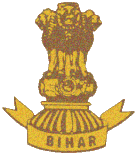Bihar Regiment
| The Bihar Regiment | |
|---|---|

Regimental Insignia of the Bihar Regiment
|
|
| Active | 1941–Present |
| Country |
|
| Branch | Army |
| Type | Infantry |
| Size | 20 Battalions |
| Regimental Centre | Danapur Cantonment, Patna |
| Motto(s) | Karam Hi Dharam (Work is Worship) |
| War Cries |
Jai Bajrang Bali (Victory to Bajrang Bali) Birsa Munda Ki Jai (Victory to Birsa Munda) |
| Mascot(s) | Sidhu-Kanhu |
| Engagements |
Burma Campaign, World War II Indo-Pakistani War of 1947 Indo-Pakistani War of 1965 Indo-Pakistani War of 1971 Kargil War |
| Decorations | 3 Ashoka Chakras, 1 Maha Vir Chakra |
| Battle honours |
Post Independence |
| Commanders | |
| Colonel of the Bihar Regiment | Lieutenant General G.S Chandel |
| Notable commanders |
Lt Gen Sant Singh, Lt Gen K S Mann, Lt Gen A R K Reddy, Lt Gen O S Lohchab, Lt Gen Balbir Singh, Brig SC Johar, Col Umesh Kumar Bojha. |
| Insignia | |
| Regimental Insignia | The Ashoka Lion |
![]() British India 1941-1947
British India 1941-1947
Post Independence
Haka , Gangaw and Batalik.
The Bihar Regiment is an infantry regiment of the Indian Army. The regiment can trace its origins back to the British Indian Army. The Bihar Regiment was formed in 1941 by regularising the 11th (Territorial) Battalion, 19th Hyderabad Regiment, and raising new battalions. The Bihar Regimental Centre (BRC) is located at Danapur Cantonment, the second oldest cantonment of India.
The Bihar Regiment traces its origins to the sepoy battalions raised in 1757 by Lord Clive of the British East India Company at Patna. These were formed by the men from the Bhojpur region of Bihar. Their success in combat impressed Mir Kasim, who began raising units trained in western combat techniques. Bihari battalions raised by Mir Kasim defeated the British in some engagements. The Bihari, or Purbiya, soldiers thereafter made up the backbone of the Bengal Infantry of the British Colonial Army. They mainly belonged to the Rajput and Bhumihar castes.
They were not only excellent soldiers, but also quick to learn and apply the tactical drills with initiative. They were disciplined when led by good officers, but capable of hostility when their beliefs and customs were disregarded. The Indian Rebellion of 1857 against the introduction of greased cartridges, was led by Bihari troops, who preferred being blown by the guns to losing their faith. Biharis thereafter were not encouraged to enter military service by the British until after World War I.
...
Wikipedia
